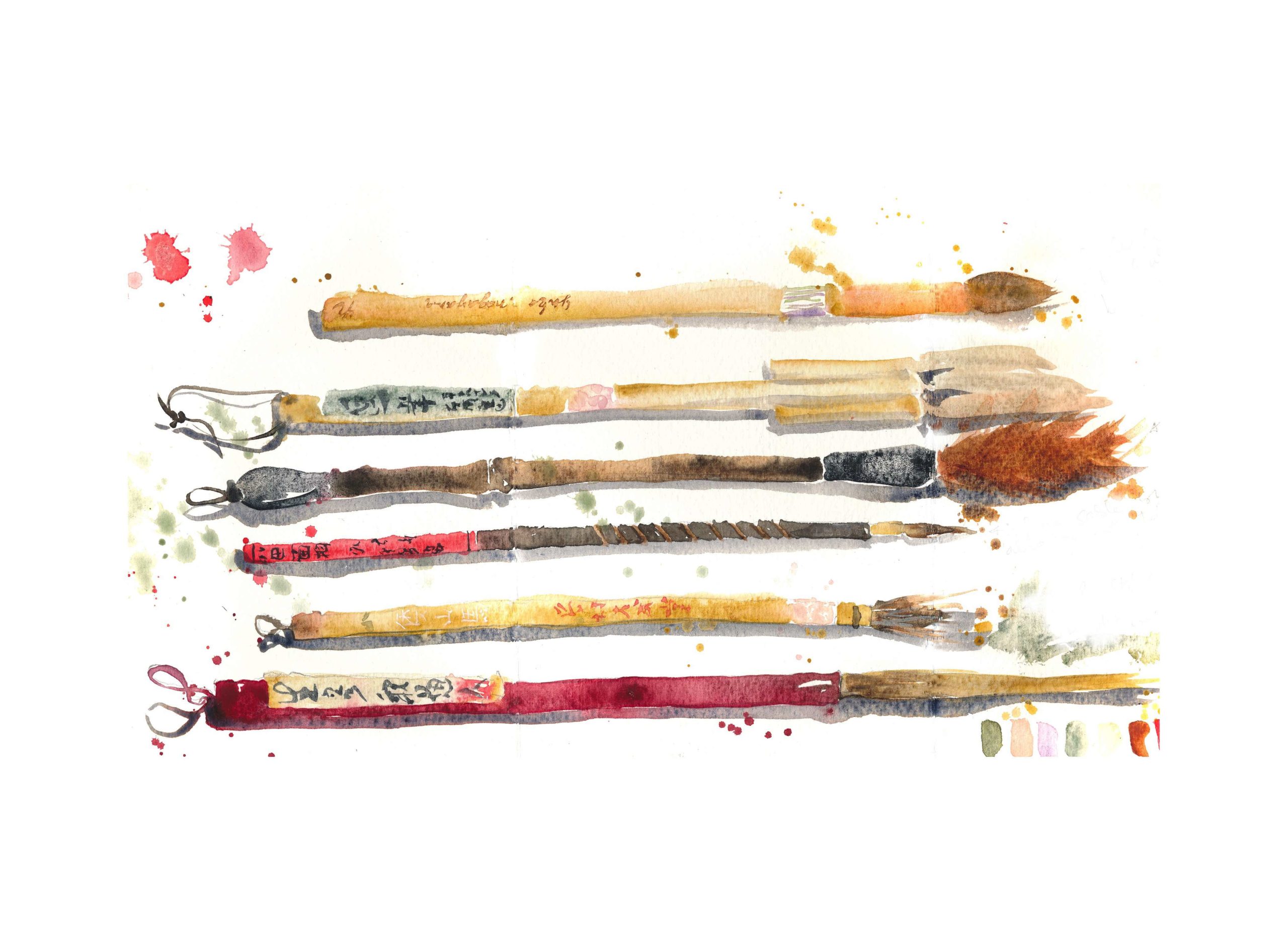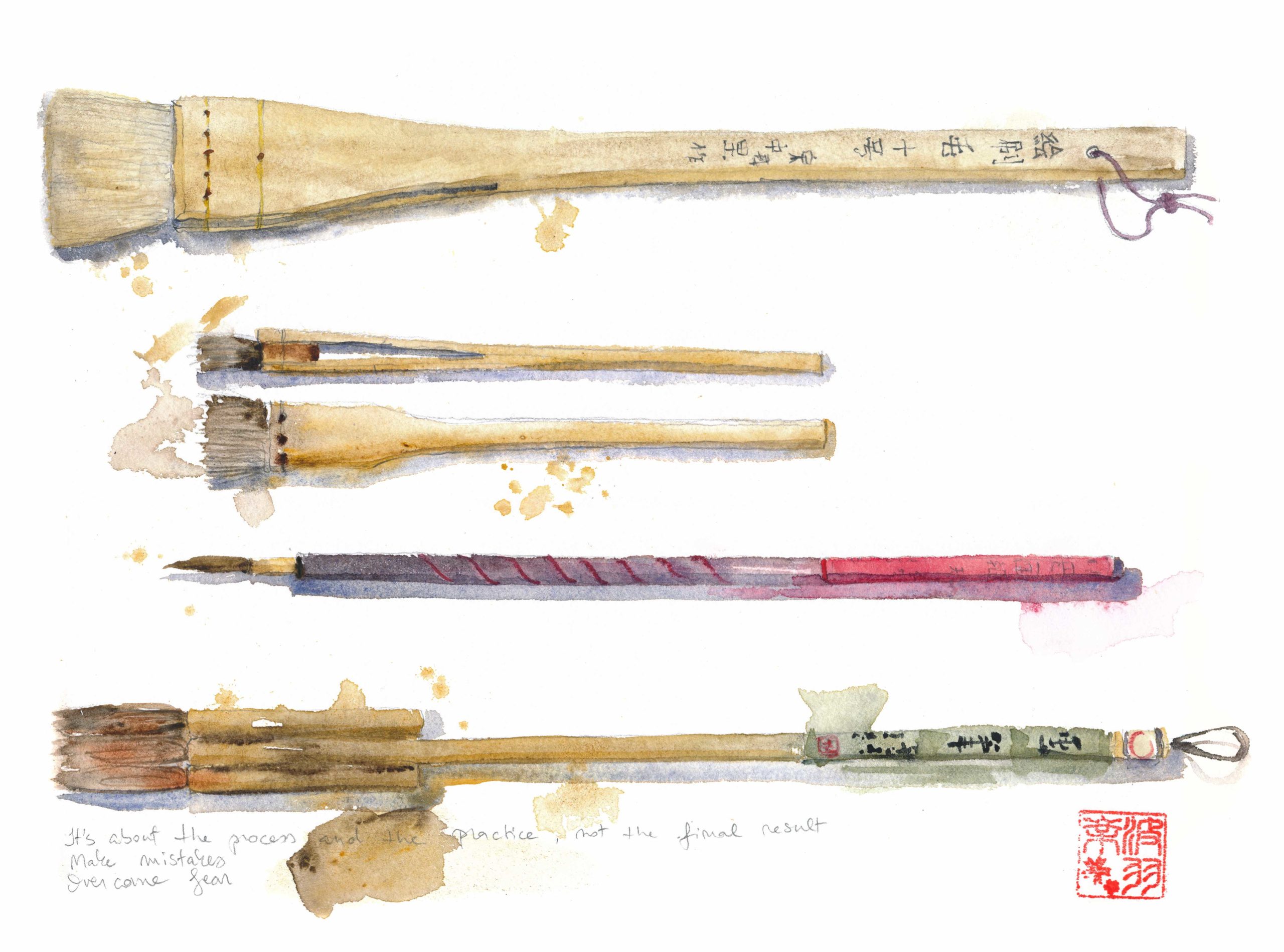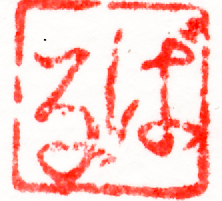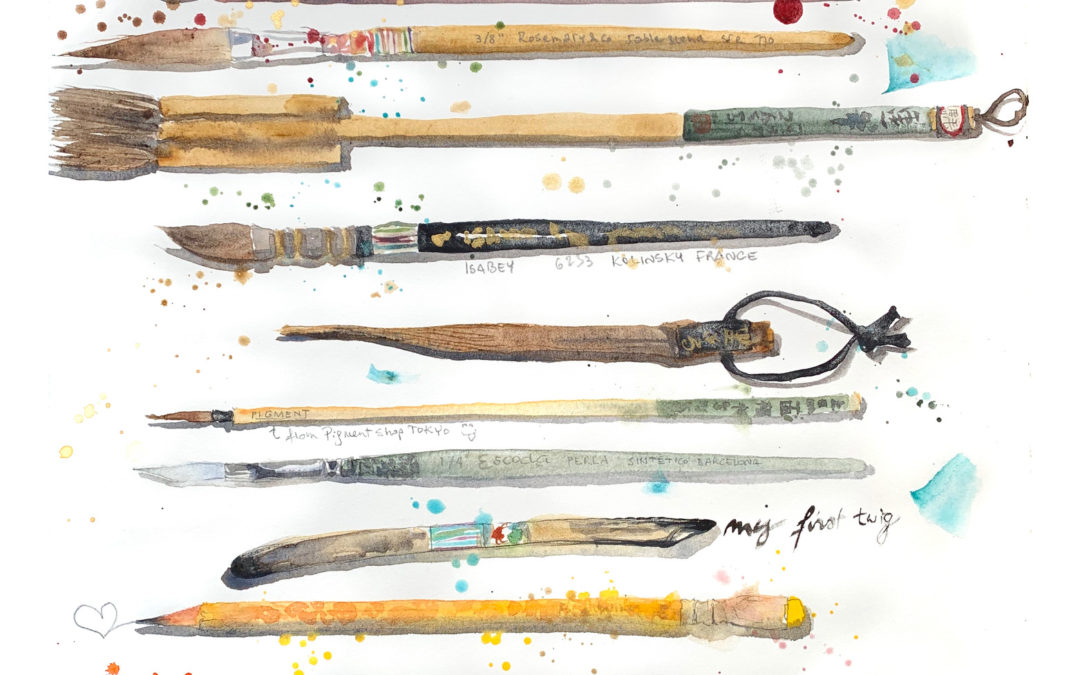It’s something that, as my husband says, I can open a store with the day I’m out of work…. Everywhere I travel I jump into the local store to look for brushes.
Here I am trying out a few that I brought back from Japan. I often make sketches of them in my sketchbooks (when I don’t have painting inspiration I paint my brushes and drawing supplies!) One sketch is a page with brushes and drawing supplies, and another sketch is just with brushes that I brought from Japan.
What I love about trying new brushes it is that those new brushes, with special hair I don’t know, oblige me to find new movements! With those Japanese brushes you don’t paint in the same way as with a Western sable hair or synthetic brush, for example: with those soft calligraphy brushes you have to hold the brush perpendicular to the paper if you want to go to a fine point or paint fine details. You can also obtain large variations in thickness.
By trying out “new” movements to get the most out of the new brush still unfamiliar to me, I also get a different perspective on what I am doing.
The tips of those Japanese calligraphy and drawing brushes turn out to be very “maneuverable,” and very long lines can be drawn with them, with varying thicknesses, without back and forth movements from paper to paint. They can hold a lot of paint and water. A fine brush for making line paintings is the Kyosuisai Sengaki, with a mixture of weasel, deer and goat hair.
A “funny” brush I bought is of stiff “deer” hair, rather stiff and the bristles stick out in all directions. No point. This is made that way on purpose. (Yamato Sanba). You can make nice “splashes” with that for painting vegetation.
The Renpitsu brushes are a composition of round brushes to a wide brush for painting nice large areas. There is also a variation in bristles: from stiffer deer bristles that you can also paint some details with, to the very (for me too) soft goat bristles.
Another special brush is all bamboo: the Megodake. It is the red brush at the top of my drawing. This is a brush made by finely splitting the tip of the bamboo. This becomes flexible once it absorbs water, and the tip does not point. It cannot be twisted, but rough straight lines can be painted. (I didn’t manage yet to paint “properly” with it… but I find it interesting)
Usually I like painting with the very flexible sable hair brushes, of course, but also with the cheaper synthetic Escoda brushes of the Perla series, for example: inexpensive and very elastic with a fantastic tip, allowing you to make super fine lines even with the thicker numbers.
Escoda also has fine travel sets with stainless steel caps (and important: a vent hole so they don’t get moldy if you forget to open them again when you get home to let them dry! 😉
My favorite brush is currently a brush with a diagonally cut sword-shaped tip, a dagger, of imitation sable hair from Rosemary’s & Co. This is a small family-run business in England.
What I also like and find important: Escoda is also a family business. Craft has something beautiful and sustainable. The Escoda Perla series also has a diagonal sword-shaped version. That diagonal flat shape gives tremendous flexibility to movements and shapes: one can paint broad areas as well as fine lines with the side and fine details with the tip.
I am curious about your experience. What is your favorite brush for the moment?





I got several of the same brushes from Pigment in Tokyo this year. They are wonderful. Pigment allows you sit down and try the brushes before purchasing. Such a delightful store!
Yessss Pigment shop is really amazing
Thank you so much dear Esme
I got some chinese brushes from a trip to China a few years ago. They came in a mat case roll and thei’re quite good. Also they have a hoop on the handle top that allows hang them to dry properly.
My favorite brushes are, unexpectedly, Kolibri red sable brushes I bought in a model store (mainly trains, boats…).
I’m using 2 models : 1 for small details and one for tree leaves.
Obviously I have a collection of Escoda you recommended to me and several Petit-Gris!
Regards,
Marie-Paule Polomé
I have a bunch of Chinese brushes from a Chinese brush painting series of classes I participated in a number of years ago before we lost our very best independent art store/dealers!!! The course was taught by a wonderful Chinese master painter who spent a fair amount of the year in China and the rest teaching and presenting his work in the Seattle area in Washington state! Many of my brushes resemble yours except for the ones that have the wide tip and what appears to be 2-3 brush tips attached to them. I LOVE my Chinese brushes and all of the Chinese paper but I never learned how to mount and frame it;-((
My favorite USA/UK brushes are ROSEMARY dagger brushes!!!
So very nice to hear from you, Barbara. I sent you messages but never heard back. Perhaps you did not receive them. Hope you are loving your move.
Dear Marlene,
I think I never received your messages, because I always reply (I don’t get a lot of messages, so it’s not difficult for me to reply to everybody. Did you send an email?
Thank you so much anyway for your comment
How lucky to be able to
Yes the Rosemary’s brushes are wonderful! Did you try Escoda also?
i’m finally getting used to my new home a bit 🙂
Much love
Barbara
Hi, Barbara!
I recently purchased via Ali Express 3 scroggy-type brushes. They come to an unbelievably fine point; they are unpredictable and are alot of fun. I’m going to try your recommendation for holding them perpendicularly for more control.
My favorite WC brushes are Escoda Versatil. Would you happen to know how Perla is different from the Versatil? Problem is, I live abroad and cannot find them in my area.
It is hard for me discern online the length of handle I need for the size I need.
I would love to hear what you think about scroggys and if holding them at a 90 degree angle would help. any ideas on Escoda? Any advice would be greatly appreciated!
Yours,
Carol
Dear Carol,
I don’t know what are “scroggy” brushes. I will look into it and try it out and let you know.
But I don’t like to order brushes in US because it costs a lot of taxes…
Definitely when you hold your brush more vertical, with any type of brush, you’ll be able to control the pressure on the tip better, to have fine lines. If you want to make larges washes of course, you might want to tilt your brush to make larger brush strokes.
I think you can order Escoda brushes directly on the Escoda website worldwide?
The Versatil range is more delicate than the Perla series. Versatils are sable-like synthetical hair. It’s Softer and holding more water than the Perlas. The Versatils also have a very fine tip. Not quite as limber as the sables, but more so than the Perlas. I love them all !
Hi!
What is meant by “moderation”?
hello carol, I get a lot of spam on the website, So I read every message before letting it go online 🙂